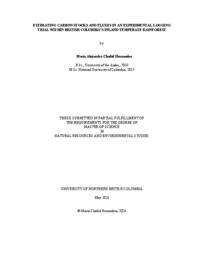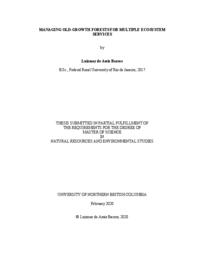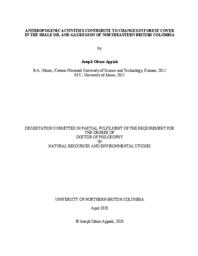Venter, Oscar
Person Preferred Name
Oscar Venter
Related Works
Content type
Digital Document
Origin Information
Content type
Digital Document
Origin Information
Content type
Digital Document
Origin Information
Content type
Digital Document
Description / Synopsis
Conserving biodiversity is principally achieved through the designation of protected areas, guided by the process of systematic conservation planning (SCP). SCP identifies networks of protected areas that represent regional biodiversity. Ecologists, planners, and decision makers may each use different spatial boundaries, scales, and extents for individual projects; these can be misaligned with the jurisdictional scope and scale of management decisions, impacting the effectiveness of resulting conservation actions. Using British Columbia as a study area, we explore how analysis design effects SCP outputs. Using ILP solvers, we measured concordance, efficiency, and equity between the varying extents (ecological and administrative) and scales (fine, coarse, provincial). Higher efficiency but lower equity results when constraints are lifted. Inversely, higher land requirements with higher equity result when constraints are imposed. We show how initial design decisions influence the priority assigned to conservation areas and find insights for striking a balance between landscape-scale and regional-scale analyses.
Origin Information
Content type
Digital Document
Description / Synopsis
Methods for cumulative threat mapping, such as the human footprint, have been rapidly developing to inform the management of biodiversity and ecosystem services. Here, I perform the first comprehensive literature review establishing what methods are used, what threats are mapped and where, and if threats or impacts are mapped statically or dynamically in time. From knowledge gained in the review, I compiled geospatial datasets in a geographic information system to map the first Canadian human footprint. Subsequently, I answer where the most intact and heavily threatened areas are, what the most prevalent threats in Canada are and assess the accuracy of the data through a technical validation. This thesis contributes to conservation science by highlighting where regional studies are lacking, which threats are not being captured, providing examples of how studies have managed dynamic timescales and mapped through to impacts, and provides key information for future conservation in Canada.
Origin Information
Content type
Digital Document
Description / Synopsis
Old-growth forest reserves offer the potential to facilitate the maintenance of multiple ecosystem services (ES), such as carbon storage, water and recreation, in managed landscapes. However, substantial challenges exist with regard to defining and identifying old-growth forests, and suitably locating priority areas for old-growth conservation. To address these issues, I developed a structure-based old-growth index using field and LiDAR metrics that allowed old-growth values to be estimated at a fine grain across a landscape. I then used a spatial prioritization tool to simulate old-growth reserves for multiple ESs. Using this framework I evaluated trade-offs between forest ESs including timber. This thesis contributes to the management of old-growth forests by providing a quantitative and repeatable framework to identify, assess and monitor old-growth values while indicating the scope for the establishment of old-growth reserves for multiple ESs.
Origin Information
Content type
Digital Document
Description / Synopsis
The boreal forest ecosystems have been changing due to varying levels of anthropogenic land use processes such as logging, oil and gas activities, and agriculture. However, the cumulative impacts of these processes are likely to lead to a lasting degradation of the boreal forest ecosystem; and thus, contributing to environmental change. In this study, methods from Landscape Ecology, GIS, and remote sensing were used to process Landsat images and spatial data for shale gas infrastructure. These datasets and methods were used for measuring and assessing the forest change pattern in a study area in northeastern British Columbia (BC). The results of the study show that gross loss (5.98%) of coniferous forest cover in the timber harvest land base (THLB) is higher than the rate of gross loss (3.22%) of the coniferous forest cover in the area outside the THLB. However, the rate of net loss in coniferous forest cover is smaller in the THLB than that of outside the THLB (net loss THLB=0.6%; net loss non-THLB=1.7%). These dynamics in forest cover suggest that it is more likely for forest cover to regenerate much faster in the THLB than outside the THLB. The quantity of forest cover loss (0.163%) from shale oil and gas well pads development is more than the amount of forest loss from shale oil and gas access roads (0.017%) and pipeline development (0.057%). A higher amount of forest fragmentation is associated with periods and locations that have a high amount of anthropogenic-induced land classes in the landscape. These results of the study could serve as the information for modelling land change and fragmentation in the future. The finding from this study could assist land managers in the allocation of land uses across space as well as the formulation of effective and efficient policy frameworks and management initiatives.
Origin Information







